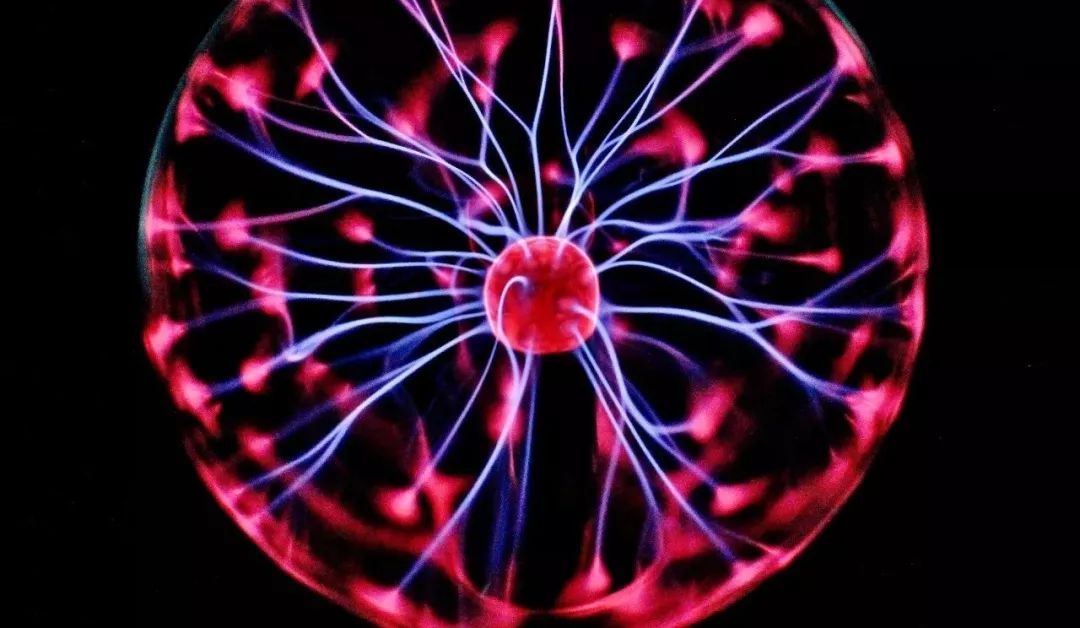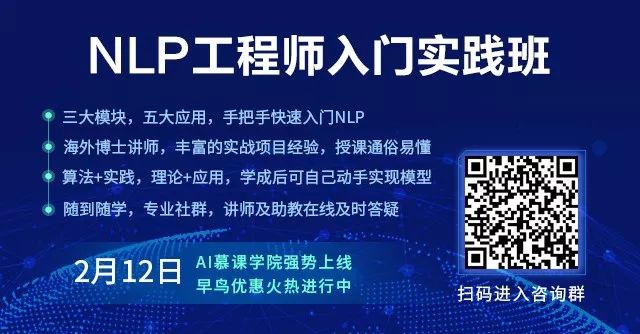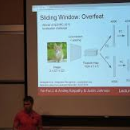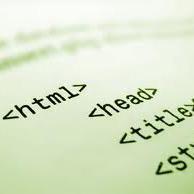干货 | 请收下这份2018学习清单:150个最好的机器学习,NLP和Python教程
本文英文出处:Robbie Allen
翻译/吴楚
校对/田晋阳
机器学习的发展可以追溯到 1959 年,有着丰富的历史。这个领域也正在以前所未有的速度进化。在之前的一篇文章(http://t.cn/R843Qbk)中,我们讨论过为什么通用人工智能领域即将要爆发。有兴趣入坑ML的小伙伴不要拖延了,时不我待!
在今年秋季开始准备博士项目的时候,我已经精选了一些有关机器学习和 NLP 的优质网络资源。一般我会找一个有意思的教程或者视频,再由此找到三四个,甚至更多的教程或者视频。猛回头,发现标收藏夹又多了 20 个资源待我学习(推荐提升效率工具 Tab Bundler)。
找到超过 25 个有关 ML 的「小抄」后,我写一篇博文(http://t.cn/R841fxk),里面的资源都有超链接。
为了帮助也在经历类似探索过程的童鞋,我把至今发现的最好的教程汇总了一个列表。当然这不是网络上有关 ML 的最全集合,而且其中有一部分内容很普通。我的目标是要找到最好的有关机器学习子方向和 NLP 的教程。
我引用了能简洁介绍概念的基础内容。我已经回避包含一些大部头书的章节,和对理解概念没有帮助的科研论文。那为什么不买一本书呢? 因为教程能更好地帮助你学一技之长或者打开新视野。
我把这博文分成四个部分:机器学习,NLP,Python和数学基础。在每一小节我会随机引入一些问题。由于这方面学习材料太丰富了,本文并未涵括所有内容。
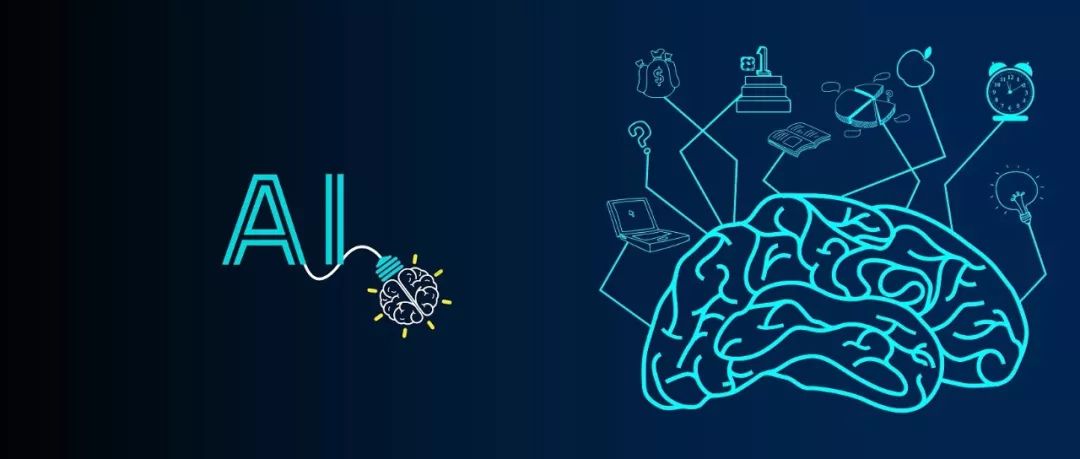
1、机器学习就是这么好玩!(medium.com/@ageitgey)
机器学习速成课程(Berkeley的ML)
Part I:https://ml.berkeley.edu/blog/2016/11/06/tutorial-1/
Part II:https://ml.berkeley.edu/blog/2016/12/24/tutorial-2/
Part III:https://ml.berkeley.edu/blog/2017/02/04/tutorial-3/
机器学习入门与应用:实例图解(toptal.com)
https://www.toptal.com/machine-learning/machine-learning-theory-an-introductory-primer
机器学习的简易指南 (monkeylearn.com)
https://monkeylearn.com/blog/a-gentle-guide-to-machine-learning/
如何选择机器学习算法?(sas.com)
https://blogs.sas.com/content/subconsciousmusings/2017/04/12/machine-learning-algorithm-use/
2、Activation and Loss Functions 激活函数与损失函数
sigmoid 神经元 (neuralnetworksanddeeplearning.com)
http://neuralnetworksanddeeplearning.com/chap1.html#sigmoid_neurons
激活函数在神经网络中有什么作用?(quora.com)
https://www.quora.com/What-is-the-role-of-the-activation-function-in-a-neural-network
神经网络的激活函数大全及其优劣 (stats.stackexchange.com)
https://stats.stackexchange.com/questions/115258/comprehensive-list-of-activation-functions-in-neural-networks-with-pros-cons
激活函数及其分类比较(medium.com)
https://medium.com/towards-data-science/activation-functions-and-its-types-which-is-better-a9a5310cc8f
理解对数损失 (exegetic.biz)
http://www.exegetic.biz/blog/2015/12/making-sense-logarithmic-loss/
损失函数(Stanford CS231n)
http://cs231n.github.io/neural-networks-2/#losses
损失函数L1 与L2 比较(rishy.github.io)
http://rishy.github.io/ml/2015/07/28/l1-vs-l2-loss/
交叉熵损失函数(neuralnetworksanddeeplearning.com)
http://neuralnetworksanddeeplearning.com/chap3.html#the_cross-entropy_cost_function
3、偏差(Bias)
神经网络中的偏差的作用(stackoverflow.com)
https://stackoverflow.com/questions/2480650/role-of-bias-in-neural-networks/2499936#2499936
神经网络中的偏差节点(makeyourownneuralnetwork.blogspot.com)
http://makeyourownneuralnetwork.blogspot.com/2016/06/bias-nodes-in-neural-networks.html
什么是人工神经网络中的偏差 (quora.com)
https://www.quora.com/What-is-bias-in-artificial-neural-network
4、感知器(Perceptron)
感知器模型(neuralnetworksanddeeplearning.com)
http://neuralnetworksanddeeplearning.com/chap1.html#perceptrons
感知器(natureofcode.com)
http://natureofcode.com/book/chapter-10-neural-networks/#chapter10_figure3
一层的神经网络(感知器模型)(dcu.ie)
http://computing.dcu.ie/~humphrys/Notes/Neural/single.neural.html
从感知器模型到深度网络(toptal.com)
https://www.toptal.com/machi ne-learning/an-introduction-to-deep-learning-from-perceptrons-to-deep-networks
5、回归算法
线性回归分析简介(duke.edu)
http://people.duke.edu/~rnau/regintro.htm
线性回归 (ufldl.stanford.edu)
http://ufldl.stanford.edu/tutorial/supervised/LinearRegression/
线性回归 (readthedocs.io)
http://ml-cheatsheet.readthedocs.io/en/latest/linear_regression.html
逻辑斯特回归 (readthedocs.io)
http://ml-cheatsheet.readthedocs.io/en/latest/logistic_regression.html
机器学习之简单线性回归教程(machinelearningmastery.com)
http://machinelearningmastery.com/simple-linear-regression-tutorial-for-machine-learning/
机器学习之逻辑斯特回归教程(machinelearningmastery.com)
http://machinelearningmastery.com/logistic-regression-tutorial-for-machine-learning/
softmax 回归(ufldl.stanford.edu)
http://ufldl.stanford.edu/tutorial/supervised/SoftmaxRegression/
6、梯度下降
基于梯度下降的学习 (neuralnetworksanddeeplearning.com)
http://neuralnetworksanddeeplearning.com/chap1.html#learning_with_gradient_descent
梯度下降(iamtrask.github.io)
http://iamtrask.github.io/2015/07/27/python-network-part2/
如何理解梯度下降算法?(kdnuggets.com)
http://www.kdnuggets.com/2017/04/simple-understand-gradient-descent-algorithm.html
梯度下降优化算法概览(sebastianruder.com)
http://sebastianruder.com/optimizing-gradient-descent/
优化算法:随机梯度下降算法 (Stanford CS231n)
http://cs231n.github.io/optimization-1/
7、生成学习
生成学习算法 (Stanford CS229)
http://cs229.stanford.edu/notes/cs229-notes2.pdf
贝叶斯分类算法之实例解析(monkeylearn.com)
https://monkeylearn.com/blog/practical-explanation-naive-bayes-classifier/
8、支持向量机
支持向量机(SVM)入门(monkeylearn.com)
https://monkeylearn.com/blog/introduction-to-support-vector-machines-svm/
支持向量机(Stanford CS229)
http://cs229.stanford.edu/notes/cs229-notes3.pdf
线性分类:支持向量机,Softmax (Stanford 231n)
http://cs231n.github.io/linear-classify/
9、后向传播算法(Backpropagation)
后向传播算法必知(medium.com/@karpathy)
https://medium.com/@karpathy/yes-you-should-understand-backprop-e2f06eab496b
来,给我图解一下神经网络后向传播算法?(github.com/rasbt)
https://github.com/rasbt/python-machine-learning-book/blob/master/faq/visual-backpropagation.md
后向传播算法是如何运行的?(neuralnetworksanddeeplearning.com)
http://neuralnetworksanddeeplearning.com/chap2.html
沿时后向传播算法与梯度消失(wildml.com)
http://www.wildml.com/2015/10/recurrent-neural-networks-tutorial-part-3-backpropagation-through-time-and-vanishing-gradients/
简易入门沿时后向传播算法(machinelearningmastery.com)
http://machinelearningmastery.com/gentle-introduction-backpropagation-time/
奔跑吧,后向传播算法!(Stanford CS231n)
http://cs231n.github.io/optimization-2/
10、深度学习
果壳里的深度学习(nikhilbuduma.com)
http://nikhilbuduma.com/2014/12/29/deep-learning-in-a-nutshell/
深度学习教程 (Quoc V. Le)
http://ai.stanford.edu/~quocle/tutorial1.pdf
深度学习,什么鬼?(machinelearningmastery.com)
http://machinelearningmastery.com/what-is-deep-learning/
什么是人工智能,机器学习,深度学习之间的区别? (nvidia.com)
https://blogs.nvidia.com/blog/2016/07/29/whats-difference-artificial-intelligence-machine-learning-deep-learning-ai/
11、优化算法与降维算法
数据降维的七招炼金术(knime.org)
https://www.knime.org/blog/seven-techniques-for-data-dimensionality-reduction
主成分分析(Stanford CS229)
http://cs229.stanford.edu/notes/cs229-notes10.pdf
Dropout: 改进神经网络的一个简单方法(Hinton @ NIPS 2012)
http://videolectures.net/site/normal_dl/tag=741100/nips2012_hinton_networks_01.pdf
如何溜你们家的深度神经网络?(rishy.github.io)
http://rishy.github.io/ml/2017/01/05/how-to-train-your-dnn/
12、长短期记忆(LSTM)
老司机带你简易入门长短期神经网络(machinelearningmastery.com)
http://machinelearningmastery.com/gentle-introduction-long-short-term-memory-networks-experts/
理解LSTM网络(colah.github.io)
http://colah.github.io/posts/2015-08-Understanding-LSTMs/
漫谈LSTM模型(echen.me)
http://blog.echen.me/2017/05/30/exploring-lstms/
小学生看完这教程都可以用Python实现一个LSTM-RNN (iamtrask.github.io)
http://iamtrask.github.io/2015/11/15/anyone-can-code-lstm/
13、卷积神经网络(CNNs)
卷积网络入门(neuralnetworksanddeeplearning.com)
http://neuralnetworksanddeeplearning.com/chap6.html#introducing_convolutional_networks
深度学习与卷积神经网络模型(medium.com/@ageitgey)
https://medium.com/@ageitgey/machine-learning-is-fun-part-3-deep-learning-and-convolutional-neural-networks-f40359318721
拆解卷积网络模型(colah.github.io)
http://colah.github.io/posts/2014-07-Conv-Nets-Modular/
理解卷积网络(colah.github.io)
http://colah.github.io/posts/2014-07-Understanding-Convolutions/
14、递归神经网络(RNNs)
递归神经网络教程 (wildml.com)
http://www.wildml.com/2015/09/recurrent-neural-networks-tutorial-part-1-introduction-to-rnns/
注意力模型与增强型递归神经网络(distill.pub)
http://distill.pub/2016/augmented-rnns/
这么不科学的递归神经网络模型(karpathy.github.io)
http://karpathy.github.io/2015/05/21/rnn-effectiveness/
深入递归神经网络模型(nikhilbuduma.com)
http://nikhilbuduma.com/2015/01/11/a-deep-dive-into-recurrent-neural-networks/
15、强化学习
给小白看的强化学习及其实现指南 (analyticsvidhya.com)
https://www.analyticsvidhya.com/blog/2017/01/introduction-to-reinforcement-learning-implementation/
强化学习教程(mst.edu)
https://web.mst.edu/~gosavia/tutorial.pdf
强化学习,你学了么?(wildml.com)
http://www.wildml.com/2016/10/learning-reinforcement-learning/
深度强化学习:开挂玩Pong (karpathy.github.io)
http://karpathy.github.io/2016/05/31/rl/
16、对抗式生成网络模型(GANs)
什么是对抗式生成网络模型?(nvidia.com)
https://blogs.nvidia.com/blog/2017/05/17/generative-adversarial-network/
用对抗式生成网络创造8个像素的艺术(medium.com/@ageitgey)
https://medium.com/@ageitgey/abusing-generative-adversarial-networks-to-make-8-bit-pixel-art-e45d9b96cee7
对抗式生成网络入门(TensorFlow)(aylien.com)
http://blog.aylien.com/introduction-generative-adversarial-networks-code-tensorflow/
《对抗式生成网络》(小学一年级~上册)(oreilly.com)
https://www.oreilly.com/learning/generative-adversarial-networks-for-beginners
17、多任务学习
深度神经网络中的多任务学习概述(sebastianruder.com)
http://sebastianruder.com/multi-task/index.html
NLP
1、NLP
《基于神经网络模型的自然语言处理》(小学一年级~上册)(Yoav Goldberg)
http://u.cs.biu.ac.il/~yogo/nnlp.pdf
自然语言处理权威指南(monkeylearn.com)
https://monkeylearn.com/blog/the-definitive-guide-to-natural-language-processing/
自然语言处理入门(algorithmia.com)
https://blog.algorithmia.com/introduction-natural-language-processing-nlp/
自然语言处理教程 (vikparuchuri.com)
http://www.vikparuchuri.com/blog/natural-language-processing-tutorial/
Natural Language Processing (almost) from Scratch (arxiv.org)
初高中生课程:自然语言处理 (arxiv.org)
https://arxiv.org/pdf/1103.0398.pdf
2、深度学习和 NLP
基于深度学习的NLP应用(arxiv.org)
https://arxiv.org/pdf/1703.03091.pdf
基于深度学习的NLP(Richard Socher)
https://nlp.stanford.edu/courses/NAACL2013/NAACL2013-Socher-Manning-DeepLearning.pdf
理解卷积神经网络在NLP中的应用(wildml.com)
http://www.wildml.com/2015/11/understanding-convolutional-neural-networks-for-nlp/
深度学习,NLP,表示学习(colah.github.io)
http://colah.github.io/posts/2014-07-NLP-RNNs-Representations/
嵌入表示,编码,注意力,预测 : 新一代深度学习因NLP的精妙而存在(explosion.ai)
https://explosion.ai/blog/deep-learning-formula-nlp
理解基于神经网络的自然语言处理(Torch实现) (nvidia.com)
https://devblogs.nvidia.com/parallelforall/understanding-natural-language-deep-neural-networks-using-torch/
深度学习在NLP中的应用(Pytorch实现) (pytorich.org)
http://pytorch.org/tutorials/beginner/deep_learning_nlp_tutorial.html
3、词向量(Word Vectors)
词袋法遇到感知器装袋法(kaggle.com)
https://www.kaggle.com/c/word2vec-nlp-tutorial
学习单词嵌入表示法(sebastianruder.com)
Part I:http://sebastianruder.com/word-embeddings-1/index.html
Part II:http://sebastianruder.com/word-embeddings-softmax/index.html
Part III:http://sebastianruder.com/secret-word2vec/index.html
单词嵌入表示的神奇力量(acolyer.org)
https://blog.acolyer.org/2016/04/21/the-amazing-power-of-word-vectors/
解释word2vec 的参数学习(arxiv.org)
https://arxiv.org/pdf/1411.2738.pdf
word2vec教程 skip-gram 模型,负采样(mccormickml.com)
http://mccormickml.com/2016/04/19/word2vec-tutorial-the-skip-gram-model/
4、Encoder-Decoder
注意力机制与记忆机制在深度学习与NLP中的应用(wildml.com)
http://www.wildml.com/2016/01/attention-and-memory-in-deep-learning-and-nlp/
序列到序列模型(tensorflow.org)
https://www.tensorflow.org/tutorials/seq2seq
利用神经网络学习序列到序列模型(NIPS 2014)
https://papers.nips.cc/paper/5346-sequence-to-sequence-learning-with-neural-networks.pdf
基于深度学习和魔法序列的语言翻译(medium.com/@ageitgey)
https://medium.com/@ageitgey/machine-learning-is-fun-part-5-language-translation-with-deep-learning-and-the-magic-of-sequences-2ace0acca0aa
如何使用编码-解码LSTM输出随机整数对应的序列(machinelearningmastery.com)
http://machinelearningmastery.com/how-to-use-an-encoder-decoder-lstm-to-echo-sequences-of-random-integers/
tf-seq2seq (google.github.io)
https://google.github.io/seq2seq
使用Python精通机器学习的七步法(kdnuggets.com)
http://www.kdnuggets.com/2015/11/seven-steps-machine-learning-python.html
机器学习的一个简例(nbviewer.jupyter.org)
http://nbviewer.jupyter.org/github/rhiever/Data-Analysis-and-Machine-Learning-Projects/blob/master/example-data-science-notebook/Example Machine Learning Notebook.ipynb
2、实例
小白如何用python实现感知器算法(machinelearningmastery.com)
http://machinelearningmastery.com/implement-perceptron-algorithm-scratch-python/
小学生用python实现一个神经网络(wildml.com)
http://www.wildml.com/2015/09/implementing-a-neural-network-from-scratch/
只用11行python代码实现一个神经网络算法(iamtrask.github.io)
http://iamtrask.github.io/2015/07/12/basic-python-network/
自己动手用ptython实现最近邻算法(kdnuggets.com)
http://www.kdnuggets.com/2016/01/implementing-your-own-knn-using-python.html
python实现长短期记忆网络的记忆机制(machinelearningmastery.com)
http://machinelearningmastery.com/memory-in-a-long-short-term-memory-network/
如何用长短期记忆递归神经网络输出随机整数(machinelearningmastery.com)
http://machinelearningmastery.com/learn-echo-random-integers-long-short-term-memory-recurrent-neural-networks/
如何用seq2seq递归神经网络学习加法运算(machinelearningmastery.com)
http://machinelearningmastery.com/learn-add-numbers-seq2seq-recurrent-neural-networks/
3、Scipy 和 numpy
Scipy课程笔记(scipy-lectures.org)
http://www.scipy-lectures.org/
Python Numpy 教程(Stanford CS231n)
http://cs231n.github.io/python-numpy-tutorial/
Numpy 与 Scipy 入门(UCSB CHE210D)
https://engineering.ucsb.edu/~shell/che210d/numpy.pdf
给科学家看的Python微课程(nbviewer.jupyter.org)
http://nbviewer.jupyter.org/gist/rpmuller/5920182#ii.-numpy-and-scipy
4、scikit-learn
PyCon会议上的Scik-learn 教程(nbviewer.jupyter.org)
http://nbviewer.jupyter.org/github/jakevdp/sklearn_pycon2015/blob/master/notebooks/Index.ipynb
Scikit-learn 中的分类算法(github.com/mmmayo13)
https://github.com/mmmayo13/scikit-learn-classifiers/blob/master/sklearn-classifiers-tutorial.ipynb
Scikit-learn教程(scikit-learn.org)
http://scikit-learn.org/stable/tutorial/index.html
简明版Scikit-learn教程(github.com/mmmayo13)
https://github.com/mmmayo13/scikit-learn-beginners-tutorials
5、Tensorflow
Tensorflow教程(tensorflow.org)
https://www.tensorflow.org/tutorials/
Tensorflow入门--CPU vs GPU (medium.com/@erikhallstrm)
https://medium.com/@erikhallstrm/hello-world-tensorflow-649b15aed18c
Tensorflow入门(metaflow.fr)
https://blog.metaflow.fr/tensorflow-a-primer-4b3fa0978be3
Tensorflow实现RNNs (wildml.com)
http://www.wildml.com/2016/08/rnns-in-tensorflow-a-practical-guide-and-undocumented-features/
Tensorflow实现文本分类CNN模型(wildml.com)
http://www.wildml.com/2015/12/implementing-a-cnn-for-text-classification-in-tensorflow/
如何用Tensorflow做文本摘要(surmenok.com)
http://pavel.surmenok.com/2016/10/15/how-to-run-text-summarization-with-tensorflow/
6、PyTorch
Pytorch教程(pytorch.org)
http://pytorch.org/tutorials/
Pytorch快手入门 (gaurav.im)
http://blog.gaurav.im/2017/04/24/a-gentle-intro-to-pytorch/
利用Pytorch深度学习教程(iamtrask.github.io)
https://iamtrask.github.io/2017/01/15/pytorch-tutorial/
Pytorch实战(github.com/jcjohnson)
https://github.com/jcjohnson/pytorch-examples
PyTorch 教程(github.com/MorvanZhou)
https://github.com/MorvanZhou/PyTorch-Tutorial
深度学习研究人员看的PyTorch教程(github.com/yunjey)
https://github.com/yunjey/pytorch-tutorial
数学
1、机器学习中的数学
机器学习中的数学 (ucsc.edu)
https://people.ucsc.edu/~praman1/static/pub/math-for-ml.pdf
机器学习数学基础(UMIACS CMSC422)
http://www.umiacs.umd.edu/~hal/courses/2013S_ML/math4ml.pdf
2、线性代数
线性代数简明指南(betterexplained.com)
https://betterexplained.com/articles/linear-algebra-guide/
码农眼中矩阵乘法 (betterexplained.com)
https://betterexplained.com/articles/matrix-multiplication/
理解叉乘运算(betterexplained.com)
https://betterexplained.com/articles/cross-product/
理解点乘运算(betterexplained.com)
https://betterexplained.com/articles/vector-calculus-understanding-the-dot-product/
机器学习中的线性代数(U. of Buffalo CSE574)
http://www.cedar.buffalo.edu/~srihari/CSE574/Chap1/LinearAlgebra.pdf
深度学习的线代小抄(medium.com)
https://medium.com/towards-data-science/linear-algebra-cheat-sheet-for-deep-learning-cd67aba4526c
复习线性代数与课后阅读材料(Stanford CS229)
http://cs229.stanford.edu/section/cs229-linalg.pdf
3、概率论
贝叶斯理论 (betterexplained.com)
https://betterexplained.com/articles/understanding-bayes-theorem-with-ratios/
理解贝叶斯概率理论(Stanford CS229)
http://cs229.stanford.edu/section/cs229-prob.pdf
复习机器学习中的概率论(Stanford CS229)
https://see.stanford.edu/materials/aimlcs229/cs229-prob.pdf
概率论(U. of Buffalo CSE574)
http://www.cedar.buffalo.edu/~srihari/CSE574/Chap1/Probability-Theory.pdf
机器学习中的概率论(U. of Toronto CSC411)
http://www.cs.toronto.edu/~urtasun/courses/CSC411_Fall16/tutorial1.pdf
4、计算方法(Calculus)
如何理解导数:求导法则,指数和算法(betterexplained.com)
https://betterexplained.com/articles/how-to-understand-derivatives-the-quotient-rule-exponents-and-logarithms/
如何理解导数,乘法,幂指数,链式法(betterexplained.com)
https://betterexplained.com/articles/derivatives-product-power-chain/
向量计算,理解梯度(betterexplained.com)
https://betterexplained.com/articles/vector-calculus-understanding-the-gradient/
微分计算(Stanford CS224n)
http://web.stanford.edu/class/cs224n/lecture_notes/cs224n-2017-review-differential-calculus.pdf
计算方法概论(readthedocs.io)
http://ml-cheatsheet.readthedocs.io/en/latest/calculus.html
---------------------------------------
为帮助对自然语言处理感兴趣的同学快速高效入门,AI慕课学院特邀新加坡南洋理工大学博士玖强老师,为大家带来《NLP工程师入门实践班:基于深度学习的自然语言处理》,课程包含NLP三大知识模块,算法理论+案例实训,搭配典型行业应用,层层递进,直通自然语言处理的本质及其应用!
早鸟价799元倒计时7天!!
更有组团优惠,4人成团每人优惠200元,快来组团报名吧!


